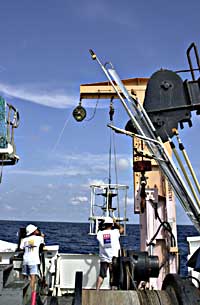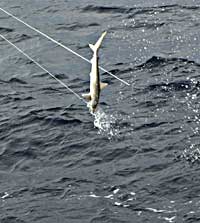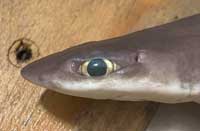|
By Dr. A. J. Godknecht, Dr. G. D. Guex
This is a continuation of the report we began in
Shark Info 3/2002
on our shark research trip to the Gulf of Mexico. Due to current events
(see report on LFA sonar in this Shark Info) we decided to bring this
report on the Oregon II mission in three instead of only two parts. The
last part of this report is thus scheduled to appear in Shark Info
1/2003.
Melissa and Jill appear and we begin by counting off 100 round hooks. We
then attach the fairly slippery chunks of mackerel to the hooks, laying
the bait lines as parallel as possible on a wooden table to ensure quick
handling when attaching them to the longline.

|
The CTD device is lowered into the
water after the longline is set.
© G. D. Guex
|
|
Tonight it’s Todd’s turn to help us set up the longline. Mark explains
the job-sharing functions between the crew and scientists. The crew
operates the equipment and the scientists do the rest. After the first
buoys and the starting weight are overboard, Todd clinks the bait lines
in ten-meter intervals to the slowly unreeling longline. We then move to
the bow of the ship to lower the CTD equipment which must measure water
data. As soon as the CTD is returned on board and cleaned with fresh
water we must wait.
Half an hour later our first longline is ready to be pulled in. This
time we bring in a series of Atlantic sharp-nosed sharks and two even
larger female spinner sharks. Rather than being marked, the spinner
sharks are killed in order to undergo more precise analysis. On each
trip Mark is called upon to comply with a series of requests for sample
material from various laboratories. Some labs request samples of flesh
from food fish in order to examine them for mercury and other heavy
metals. Others need reproductive organs for development biological
studies, and still others would like otoliths from groupers in order to
gain information on their age and growth, etc. So there is always much
more to do than simply mark and release the catch.

|
An Atlantic sharp-nosed shark
(Rhizoprionodon terranovae) is
pulled aboard at almost brutal speed.
© G. D. Guex
|
|
Next station: The only animals found on the longline are several dead
Atlantic sharp-noses – a very sad scene, indeed. In attempting to
determine why the entire catch died, CTD data revealed that only 0.6 ppm
(parts per million) of oxygen were found on the seafloor – much too
little to guarantee survival of the sharp-noses on the hook for longer
than several minutes.
Two longlines to go, and then towards six a.m., breakfast time. Each
morning Paul prepares a breakfast which would undoubtedly be considered
an extensive lunch in Switzerland. For snacks he makes sure we have
fresh fruit, Gatorade, ice tea and, of course, liters of coffee. After
all, in these temperatures one has to pay attention to replenishing the
body fluid household.
Up until the day shift starts, we lower a total of four longlines with
mediocre results, although at least we found no more dead animals. We
finish around 12 noon, quite exhausted but ready to again spend our free
time looking over the shoulders of John Carlson and his girl group as
the day shift begins their work.
After a second day of barely three hours sleep we can hardly get out of
bed. But after all, we don’t find ourselves on a shark research trip
every day. So we take over the longline which the day shift had set. The
composition of species caught at the last three stations clearly
reflects our proximity to the Mississippi delta where the seafloor is
flat. On the longline we find about 20 catfish and two eels. But we’re
lucky. Between the catfish we pull two bull sharks (Carcharhinus leucas)
towards the ship. Barely measuring 1.30 meters in length, these
medium-sized sharks are already so heavy that we cannot haul them
aboard. We must thus be satisfied with estimating their length,
determining their sex and marking them below the dorsal fins. Finally we
give them their freedom by cutting off the bait line.
The next station is a three-hour sail away. Time to relax a bit and
enjoy some biology. With great interest we observe some flying fish
appearing in the cone of light stemming from the floodlight on deck, or
try to determine the species of jellyfish which we see passing in the
water. Our two girl colleagues disappear and spend time looking at some
TV series or DVDs in the TV room. As we learned during our trip, this
was apparently their main activity when not working or sleeping.
The next station is also located near the Mississippi delta region.
After setting the lines and receiving initial data from the CTD we fear
the worst for our catch because only 0.6 ppm of oxygen is registered on
the seafloor. All of the sharks pulled on board, including two spinner
sharks, are dead.
Dasselbe bei der nächsten Station, doch hier haben wir – besser
We find the same situation at the next station, although here we –
better said one shark – has some luck. Of the four sharks we pull
aboard, three are dead and one 1.35 meter long finetooth shark
(Carcharhinus isodon) is more dead than alive. Time is vital if we want
to save him. We measure him, decide to forget about the marking and
return him to the water as quickly as possible. Our last glimpse showed
him swimming slowly, rather than just drifting down into the water – a
good sign. We wish him luck.
After 10 hours of sleep the world looks considerably clearer again.
Still, it’s a strange feeling when in a barely conscious state, the
first thing you see in the morning is a lady holding a shark head.
In the meantime we arrived at station 14. According to the day shift,
barely any more sharks have been caught since leaving the Mississippi
Delta. As we move towards the open sea we notice the difference in both
the water’s color and the new species on the line. The Gulf is
considerably deeper here than in the coastal region. We catch two red
snappers and a yellow-banded grouper. Melissa is quite excited because
she works with these groupers. After taking some otoliths and tissue
samples, the fish winds up in the kitchen. Somehow Paul’s kitchen aid
has a sixth sense because he always manages to appear precisely then
when something of culinary interest is pulled on board.

|
The Cuban dogfish has very large eyes which appear to shine green.
© G. D. Guex
|
|
Although we catch and mark a total of only six sharks during the entire
shift, we have special forms that include a scalloped hammerhead
female (Sphyrna lewini) and, at a particularly deep area at a depth of
150 meters two small Cuban dogfish (Squalus cubensis) with huge eyes
which glow green under certain light conditions. This coloring is caused
by the light amplifier (Zona pellucida) found behind the retinal
cells. This so-called silver coating reflects the light,
similar to cats’ eyes, and thus lands with almost double the intensity
on the retinal cells.
The seventh day, the fourth at sea, turned out to be extremely exciting
and, being well rested, we also managed to enjoy the beautiful weather
and the calm sea.
To be continued in the next issue of Shark Info
* Alexander J. Godknecht
and Gaston D. Guex are biologists and
members of the Shark Foundation Board of Trustees and the Shark Info
editorial staf.
May be published only by indicating the source: Shark Info / Dr. A. J. Godknecht, Dr. G. D. Guex
|



